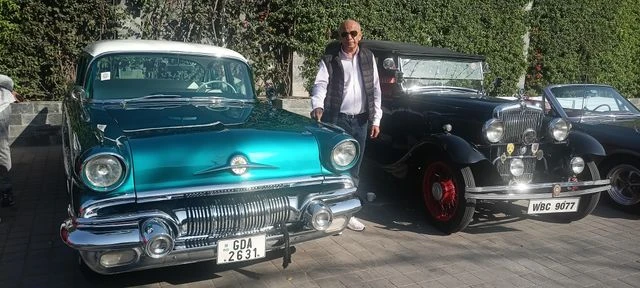On Sunday morning, the sun shone brightly on vintage cars parked in symmetry on the grounds of ITC Maurya in New Delhi. The owners were making sure the old beauties turned up spick and span for a rally organised by ITC Hotels in partnership with the Heritage Motoring Club of India. The rally would end at ITC Grand Bharat in Gurugram, Haryana, later in the day.
Some owners were simply sipping their cuppa, relishing the mood and waiting for the flag-off. The outlook towards these cars, they said, has changed in recent years.
“Earlier people used to export these cars,” said Arjun, who came to participate in the rally with his grey left-hand drive 1964 Willys CJ-3B. “But now with the new rules, the trend has reversed. People are now importing these cars,” added Arjun, who only identified his first name.
Before 2021, there was no legal process to register vintage cars in India. In July 2021, Minister of Road Transport and Highways Nitin Gadkari announced the formalisation of these cars by amending the Central Motor Vehicle Act, 1989.
According to the new rules, all four-wheelers that are at least 50 years older than their first date of registration are now considered “vintage”. However, these cars need to be in their original form with no “substantial overhaul”.
The notification also laid down the rules for re-registration of these cars.
More From This Section
Arjun told Business Standard that these cars were also exempted from the National Green Tribunal’s 2015 ruling that imposed a ban on all diesel vehicles older than 10 years and petrol vehicles older than 15 years in Delhi-National Capital Region.
“The process has become really simple.” But, he added, “The only challenge is that the traffic cops still harass us.”
The Centre’s notification states that these cars would not be allowed to be driven on roads “for regular/commercial purposes”. Several vintage car owners said that the restrictions were not clearly defined and it led to miscommunication on the ground.
Arjun said, “They (traffic police) haven’t gotten the message yet. So we still need to show the notification and the papers.”
Prashant Gondal, who owns a Pontiac 1957, said that these cars could be taken to a mechanic or petrol pumps but “even then the cops can stop you”.
)
)
Prashant Gondal with his Pontiac 1957 (Photo: Raghav Aggarwal)
Last year, Delhi resident Kaleem Khan’s 1948 Humber Hawk III was seized by the state government citing its scrapping policy. Khan moved the court and later the Delhi High Court stayed the seizure of the car. It asked the Delhi government to clarify its stance on vintage vehicles.
Last month, the Delhi government issued guidelines for the “end-of-life” vehicles stating that their owners can get the cars released by paying a fine of Rs 10,000 and giving an undertaking that these will not be driven on city roads.
The owners would also need to park the cars in a private space and not in public.
The notification also mentioned that if the vehicles were diesel-run and older than 10 years, and impounded for a second time, they would not be released and simply scrapped. The scrap value would be digitally sent to the owner within 15 days of it being accepted by the registered vehicle scrapper facility.
Amaan Kidwai, area manager of North (luxury hotels) and general manager at ITC Maurya, said that for the rally, they took the permission of Delhi’s traffic police.
“They have been very cooperative. They have provided us with the necessary permissions here as well as in Gurugram and Manesar,” he said.
Pursuit of passion
Despite the hurdles and confusion, classic and vintage cars continue to be in demand in India. According to Knight Frank’s The Wealth Report 2024, released last month, classic cars were the fourth most preferred investment of passion for ultra-rich Indians in 2023. Globally, it stood in the third spot.
The report also highlighted that cars as an investment have yielded a return of 82 per cent globally in the last 10 years.
However, most people at the rally said they owned the cars not as an investment option but to pursue their passion.
“There is investment. Investment of time, investment of money,” said Indermeet, the owner of a maroon 1954 Willys CJ-3A who only identified his first name. “But there is no return on investment.”
“It’s a passion. It’s difficult to make money out of these cars,” added Arjun.
Agreed Gondal, “These cars do have a notional value and some people would sell them for profit, too. But that depends on how many cars one has and what is his vision.”
)
)
Arjun and Indermeet with their Willy's jeeps (Photo: Raghav Aggarwal)

)
